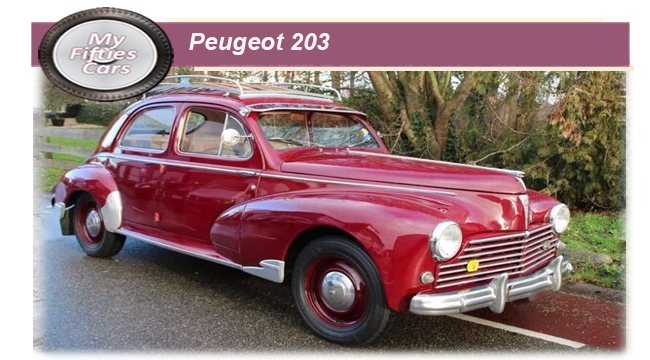 Peugeot's first entirely post-World War Two car was the 203, which made its public debut at the Paris Motor Show of 1947.
Peugeot's first entirely post-World War Two car was the 203, which made its public debut at the Paris Motor Show of 1947.
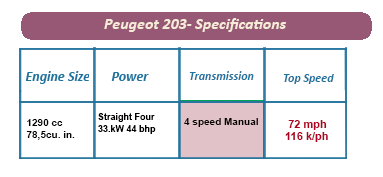 Executives at Peugeot reportedly were ready to admit that the car had actually been under development during the war year, apparently under the highest secrecy.
Executives at Peugeot reportedly were ready to admit that the car had actually been under development during the war year, apparently under the highest secrecy.
The French public, starved for choice in new vehicles since the war years, welcomed the 203 with open arms.
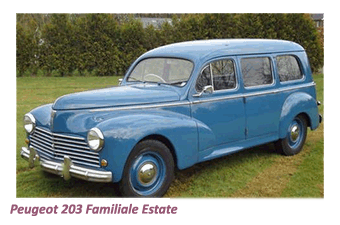 And with good reason as not only was the Peugeot 203 practical and inexpensive, it was also extremely stylish in appearance, thanks to its streamlined monocoque unibody shape offset by headlamps integrated into its fenders.
And with good reason as not only was the Peugeot 203 practical and inexpensive, it was also extremely stylish in appearance, thanks to its streamlined monocoque unibody shape offset by headlamps integrated into its fenders.
.
The Peugeot 203's wider than average grille made up from horizontal bars tapered outwards at the base to create a dramatic effect.
The front doors of the four-door sedans were rear-hinged suicide" style) with exposed hinges, while its back doors were front-hinged. A sunroof came as standard.
 Round parking lights stood below and outboard of the headlamps, while wheel openings had a pleasant rounded appearance.
Round parking lights stood below and outboard of the headlamps, while wheel openings had a pleasant rounded appearance.
The 203's overall appearance was a revelation for the style-seeking public, as it was completely different from the prewar 'Airflow style that Peugeot had long favoured.
![]()
According to the motoring media of the time, the 203's designers had taken their inspiration in the design theme from many prewar and early postwar American sedans.
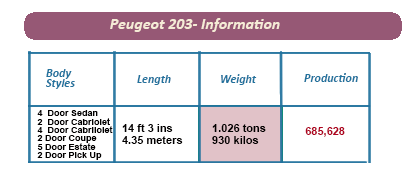 Despite the initial very positive reaction, didn't take too long however for the honeymoon period to wear off, as Peugeot found it challenging to keep up with demand for the 203, available initially in saloon form only, due to a combination of labour disputes and chronic shortages of raw materials.
Despite the initial very positive reaction, didn't take too long however for the honeymoon period to wear off, as Peugeot found it challenging to keep up with demand for the 203, available initially in saloon form only, due to a combination of labour disputes and chronic shortages of raw materials.
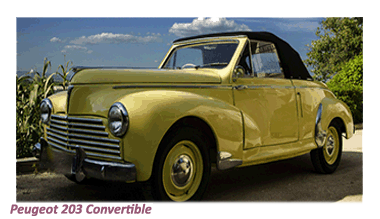 With these differences and problems behind them, Peugeot began to enjoy the success that they predicted with the 203.
With these differences and problems behind them, Peugeot began to enjoy the success that they predicted with the 203.
The company gradually began to extend the range to include the choice of either two or four-door convertibles, a two-door coupe, and even a two-door pickup, which turned out to be particularly in demand with France's considerable farming community, and owners of small business in general.
 Irrespective of its body shape, the 203 was powered by the same four-cylinder
Irrespective of its body shape, the 203 was powered by the same four-cylinder
![]()
During its eleven-year production run, the 4-door saloon consistently remained the best seller in the series although the 6-seat Familiale estate took a significant share in the market in France and North-West Europe.
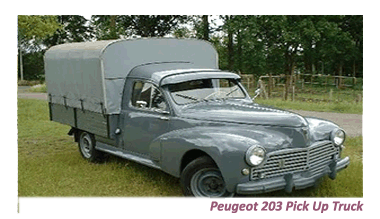 The Familiale stood out, not because of its outstanding good looks, instead of as an ideal, no-nonsense dual-purpose vehicle, with its three rows of seats, ideal for larger families, or folded forward to accommodate a lot of cargo.
The Familiale stood out, not because of its outstanding good looks, instead of as an ideal, no-nonsense dual-purpose vehicle, with its three rows of seats, ideal for larger families, or folded forward to accommodate a lot of cargo.
 The 203 Estate was the forerunner to a number of dual-purpose vehicles that dominated the market in Europe and across the World.
The 203 Estate was the forerunner to a number of dual-purpose vehicles that dominated the market in Europe and across the World.
The Peugeot 203 was steadily phased out in Europe from the mid-Fifties onwards as the new 403 was easing into its place. Despite that, the 203 remained very much in demand across South America, Asia, and Africa where it continued in production until the end of the Fifties.


